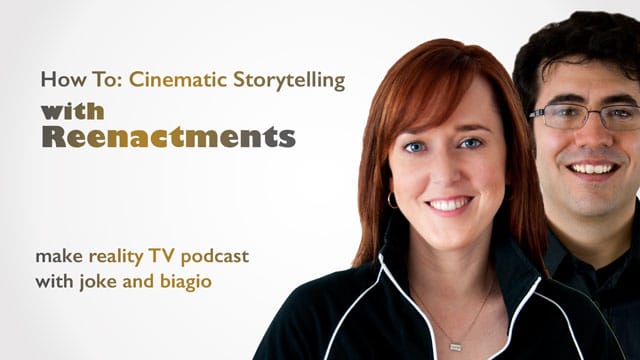Podcast: Play in new window | Download (Duration: 26:31 — 25.6MB)
Subscribe: RSS
Reenactments in documentary, film, and TV projects give visual life to past events. They do so by re-creating those moments in a cinematic way. You’ve seen them in groundbreaking films like The Thin Blue Line by Errol Morris, HBO’s recent The Jinx, every crime show on Discovery ID, and in our own upcoming series, Snapped: She Made Me Do It on Oxygen. But what goes into creating the visual style for your reenactments? What are your must-have shots? How do you keep things from getting generic? And why are reenactments a touchy and sometimes controversial subject?

Reenactments That Are Satisfying to Make…and to Watch.
We love reenactments (you might have guessed, since we’re making a show that features them.)
However, you can’t talk about any type of re-creation in the unscripted world without first acknowledging it’s a sometimes touchy subject.
[tweet_box]How To: Cinematic Storytelling with Reenactments[/tweet_box]
In a great article at Flavorwire called The Case for Reenactment in Documentary Cinema some of the pros and cons of reenactments are explored. In the end, acclaimed documentarian Errol Morris is pretty clear that, like any filmmaking technique, reenactments can support or subvert the truth.
Not everyone agrees. Check out this interesting read Why Reenactments Never Work from The New Yorker.
We tend to side with Errol Morris, but understand the points made in the New Yorker article above (and we do agree that there’s enough ominous drone music out there!)
Reenactments — What Are They Based On?
As mentioned in our last podcast episode, on Snapped: She Made Me Do It we work hard to include families of victims, police officers who worked the crimes, and anyone else who can shed light on what really happened.
It’s then up to us to film reenactments that tell their stories in an engaging way.
Multiple Points of View?
Some of our reenactments are told from two points of view — that of the accused, and that of the accuser.
That means audiences will often see two versions of events, and we need to make sure they understand whose version they’re looking at.
It’s a tall order, one we take seriously, and one we discuss in great detail on today’s “nuts and bolts” reenactments podcast.
Just a few of the things we cover today:
- Filming cinematic reenactments
- Finding styles for reenactments based on themes in your story
- Specific themes we used to create reenactments in Snapped: She Made Me Do It
- Where reenactments can go wrong in film and TV
- Avoiding generic reenactments when you’re on a small budget and tight deadline
And so much more! Press that giant red “PLAY” button above and learn all about reenactments and the hands-on techniques that will help you make them shine.
Transcript Coming Soon!
Helpful and Related Links
A past episode we did covering developing, pitching and selling shows featuring reenactments.
Our official announcement for Snapped: She Made Me Do It
E! Online did a great announcement about the show.
Our compnay has officially been “trade speaked” — Oxygen Makes Joke Crime Order
Okay, you know why you’re reading this…you want to break into unscripted television! One way to do that…pitch to us, of course! Let’s make some TV together. Here’s how:
